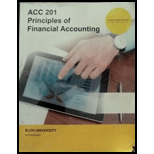
Concept explainers
Concept Introduction:
Accounting equation represents the mathematical relationship between assets, liabilities and equity. According to this equation, assets are equal to the sum of liabilities and equity. The formal for basic accounting equation is as follows:
Requirement-1:
To indicate:
The effect of the purchase of supplies as expense using the horizontal model
Concept Introduction:
Adjusting entries: The adjusting entries are recorded at the end to each accounting period to adjust the account as per the accrual concept of accounting. The adjusting entries include adjustment of depreciation, adjustment of payable expenses, and adjustment of receivable revenue.
Accounting equation represents the mathematical relationship between assets, liabilities and equity. According to this equation, assets are equal to the sum of liabilities and equity. The formal for basic accounting equation is as follows:
Requirement-2:
To indicate:
The effect of the adjustment for supplies using the horizontal model
Concept Introduction:
Adjusting entries: The adjusting entries are recorded at the end to each accounting period to adjust the account as per the accrual concept of accounting. The adjusting entries include adjustment of depreciation, adjustment of payable expenses, and adjustment of receivable revenue.
Accounting equation:
Accounting equation represents the mathematical relationship between assets, liabilities and equity. According to this equation, assets are equal to the sum of liabilities and equity. The formal for basic accounting equation is as follows:
Requirement-3:
To indicate:
The effect of the alternative way of recording the supplies purchase using the horizontal model
Concept Introduction:
Adjusting entries: The adjusting entries are recorded at the end to each accounting period to adjust the account as per the accrual concept of accounting. The adjusting entries include adjustment of depreciation, adjustment of payable expenses, and adjustment of receivable revenue.
Accounting equation:
Accounting equation represents the mathematical relationship between assets, liabilities and equity. According to this equation, assets are equal to the sum of liabilities and equity. The formal for basic accounting equation is as follows:
Requirement-d:
To indicate:
The effect of the adjustment required using the alternative way of recording the supplies purchase using the horizontal model
Concept Introduction:
Adjusting entries: The adjusting entries are recorded at the end to each accounting period to adjust the account as per the accrual concept of accounting. The adjusting entries include adjustment of depreciation, adjustment of payable expenses, and adjustment of receivable revenue.
Accounting equation:
Accounting equation represents the mathematical relationship between assets, liabilities and equity. According to this equation, assets are equal to the sum of liabilities and equity. The formal for basic accounting equation is as follows:
Requirement-e:
To indicate:
The effect of the above two different set of ways to record the supplies expense on the income statement and the
Want to see the full answer?
Check out a sample textbook solution
Chapter 4 Solutions
Principles of Financial Accounting (Elon University)
- What is the correct price and accounting questionarrow_forwardGlacier Textiles uses a standard costing system. The following data are available for November: • • Actual quantity of direct materials purchased: 25,000 yards Standard price of direct materials: $4 per yard Material price variance: $1,500 favorable Material quantity variance: $2,800 unfavorable Required: What is the actual price per yard of direct materials purchased in November?arrow_forwardNeed answerarrow_forward
- What is the amount and character of recognized gain or loss on the sales of this financial accounting question?arrow_forwardStandard costs are NOT used for: a. determining actual costs. b. preparing budgets and forecasts. c. evaluating the performance of workers and management. d. developing appropriate selling prices.arrow_forwardWhat was the number of units started or transferred inarrow_forward

 AccountingAccountingISBN:9781337272094Author:WARREN, Carl S., Reeve, James M., Duchac, Jonathan E.Publisher:Cengage Learning,
AccountingAccountingISBN:9781337272094Author:WARREN, Carl S., Reeve, James M., Duchac, Jonathan E.Publisher:Cengage Learning, Accounting Information SystemsAccountingISBN:9781337619202Author:Hall, James A.Publisher:Cengage Learning,
Accounting Information SystemsAccountingISBN:9781337619202Author:Hall, James A.Publisher:Cengage Learning, Horngren's Cost Accounting: A Managerial Emphasis...AccountingISBN:9780134475585Author:Srikant M. Datar, Madhav V. RajanPublisher:PEARSON
Horngren's Cost Accounting: A Managerial Emphasis...AccountingISBN:9780134475585Author:Srikant M. Datar, Madhav V. RajanPublisher:PEARSON Intermediate AccountingAccountingISBN:9781259722660Author:J. David Spiceland, Mark W. Nelson, Wayne M ThomasPublisher:McGraw-Hill Education
Intermediate AccountingAccountingISBN:9781259722660Author:J. David Spiceland, Mark W. Nelson, Wayne M ThomasPublisher:McGraw-Hill Education Financial and Managerial AccountingAccountingISBN:9781259726705Author:John J Wild, Ken W. Shaw, Barbara Chiappetta Fundamental Accounting PrinciplesPublisher:McGraw-Hill Education
Financial and Managerial AccountingAccountingISBN:9781259726705Author:John J Wild, Ken W. Shaw, Barbara Chiappetta Fundamental Accounting PrinciplesPublisher:McGraw-Hill Education





